
The persimmon is the edible fruit of a number of species of trees in the genus Diospyros. The most widely cultivated of these is the Oriental persimmon, Diospyros kaki – Diospyros is in the family Ebenaceae, and a number of non-persimmon species of the genus are grown for ebony timber. In 2019, China produced 75% of the world total of persimmons.
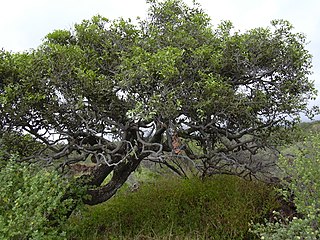
The Ebenaceae are a family of flowering plants belonging to order Ericales. The family includes ebony and persimmon among about 768 species of trees and shrubs. It is distributed across the tropical and warmer temperate regions of the world. It is most diverse in the rainforests of Malesia, India, tropical Africa and tropical America.

Diospyros is a genus of over 700 species of deciduous and evergreen trees and shrubs. The majority are native to the tropics, with only a few species extending into temperate regions. Individual species valued for their hard, heavy, dark timber, are commonly known as ebony trees, while others are valued for their fruit and known as persimmon trees. Some are useful as ornamentals and many are of local ecological importance. Species of this genus are generally dioecious, with separate male and female plants.

Diospyros virginiana is a persimmon species commonly called the American persimmon, common persimmon, eastern persimmon, simmon, possumwood, possum apples, or sugar plum. It ranges from southern Connecticut to Florida, and west to Texas, Louisiana, Oklahoma, Kansas, and Iowa. The tree grows wild but has been cultivated for its fruit and wood since prehistoric times by Native Americans.
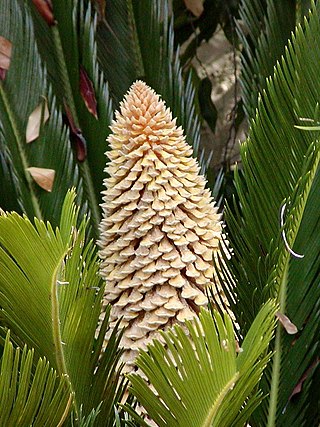
Cycas revoluta is a species of gymnosperm in the family Cycadaceae, native to southern Japan including the Ryukyu Islands. It is one of several species used for the production of sago, as well as an ornamental plant. The sago cycad can be distinguished by a thick coat of fibers on its trunk. The sago cycad is sometimes mistakenly thought to be a palm, although the only similarity between the two is that they look similar and both produce seeds. The leaves grow from the trunk and start out as small leaves near the centre of the plant.

Diospyros melanoxylon, the Coromandel ebony or East Indian ebony, is a species of flowering tree in the family Ebenaceae native to India and Sri Lanka; it has a hard, dry bark. Its common name derives from Coromandel, the coast of southeastern India. Locally it is known as temburini or by its Hindi name tendu. In Odisha, Jharkhand, and Assam, it is known as kendu. In Andhra Pradesh, and Telangana it is known as tuniki. The leaves can be wrapped around tobacco to create the Indian beedi, which has outsold conventional cigarettes in India. The olive-green fruit of the tree is edible.

Diospyros blancoi,, commonly known as velvet apple, velvet persimmon, kamagong, or mabolo tree, is a tree of the genus Diospyros of ebony trees and persimmons. It produces edible fruit with a fine, velvety, reddish-brown fur-like covering. The fruit has a soft, creamy, pink flesh, with a taste and aroma comparable to peaches.
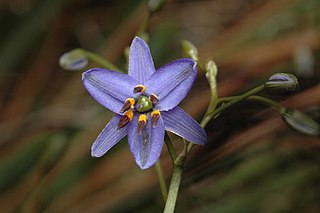
Dianella is a genus of about forty species of flowering plants in the monocot family Asphodelaceae, commonly known as flax lilies. Plants in this genus are tufted herbs with more or less linear leaves and bisexual flowers with three sepals more or less similar to three petals and a superior ovary, the fruit a berry. They occur in Africa, South-east Asia, the Pacific Islands, New Zealand and Australia.
Shorea revoluta is a species of plant in the family Dipterocarpaceae. It is a tree endemic to Borneo.

Dianella revoluta, commonly known as blueberry lily, blue flax-lily, or black-anther flax-lily, a species of flowering plant in the family Asphodelaceae and is endemic to, and widespread in Australia. It is a tufted, perennial herb with grass-like leaves and up to nine blue or violet flowers with six tepals, and stamens with bright yellow filaments and pale brown to almost black anthers.
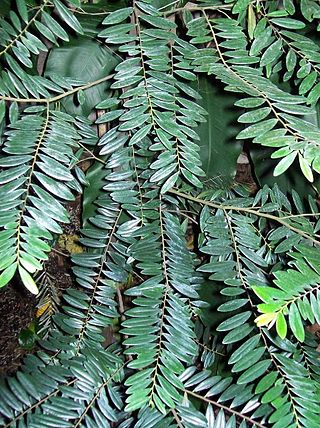
Diospyros seychellarum, locally known as bwa sagay, is a rare endemic plant from the Seychelles. It occurs on the islands of Mahé, Praslin, Silhouette and Felicite.

Pyrostria revoluta, formerly Scyphochlamys revoluta, is a species of flowering plant in the family Rubiaceae that lives on the island of Rodrigues.
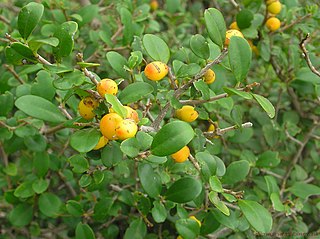
Diospyros ferrea, known as black ebony, is a tree in the ebony family, distributed in Burma (Myanmar), Cambodia, India, Indonesia, Malay Peninsula, Philippines, Sri Lanka, Thailand, Laos (Khammouan) and Taiwan.
Diospyros andamanica is a tree in the family Ebenaceae. It grows up to 20 metres (70 ft) tall. Twigs are rusty brown or blackish. Inflorescences bear up to 30 or more flowers. The fruits are roundish to ellipsoid, up to 3 cm (1 in) in diameter. The tree is named after the Andaman Islands. Habitat is mixed dipterocarp forests from sea level to 700 metres (2,300 ft) altitude. D. andamanica is found in the Andaman Islands, Sumatra, Peninsular Malaysia and Borneo.
Diospyros pyrrhocarpa is a tree in the family Ebenaceae. It grows up to 23 metres (80 ft) tall. Twigs dry greyish to brownish. Inflorescences bear up to three flowers. The fruits are roundish to ovoid-ellipsoid, up to 5 cm (2 in) in diameter. The specific epithet pyrrhocarpa is from the Greek meaning "fiery red or yellow fruits". Habitat is lowland mixed dipterocarp forests. D. pyrrhocarpa is found from the Andaman and Nicobar Islands to the Philippines. In Cebu and Negros Regions in the Philippines, the tree is commonly known as Kunalum.
Diospyros venosa is a tree in the family Ebenaceae. It is native to Southeast Asia, from the Maluku Islands to Myanmar. It provides raw material for handicrafts, traditional medicine and fuel.

Ledebouria revoluta, the south Indian squill, is a flowering plant species in the genus Ledebouria found in Southern Africa and India.
Iris revoluta is a plant species in the genus Iris, it is also in the subgenus Iris. It is a rhizomatous perennial, from a small area in Salento, Italy. It has (sword-shaped) or falcate (sickle-shaped) glaucous leaves, tall slender stem with several short branches and 2–4 fragrant flowers in dark violet, purple, violet and pale violet. It is rarely cultivated as an ornamental plant in temperate regions.

Diospyros revaughanii is a rare species of tree in the family Ebenaceae (ebony).













